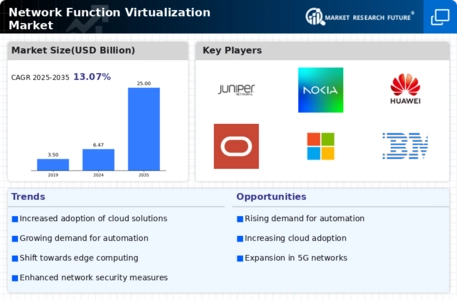-
FACTOR ANALYSIS
-
\r\n\r\n\r\nValue chain Analysis
-
\r\n\r\n\r\nPorter's
-
Five Forces Analysis
-
\r\n\r\n\r\nBargaining Power of Suppliers
-
\r\n\r\n\r\nBargaining
-
Power of Buyers
-
\r\n\r\n\r\nThreat of New Entrants
-
\r\n\r\n\r\nThreat
-
of Substitutes
-
\r\n\r\n\r\nIntensity of Rivalry
-
\r\n\r\n\r\n\r\n\r\nCOVID-19
-
Impact Analysis
-
\r\n\r\n\r\nMarket Impact Analysis
-
\r\n\r\n\r\nRegional
-
Impact
-
\r\n\r\n\r\nOpportunity and Threat Analysis
-
\r\n\r\n\r\n\r\n\r\n\r\n\r\n
-
\r\n
-
\r\n\r\n\r\nNetwork
-
Function Virtualization Market, BY Application (USD Billion)
-
\r\n\r\n\r\nTelecommunication
-
\r\n\r\n\r\nData
-
Analytics
-
\r\n\r\n\r\nNetwork Security
-
\r\n\r\n\r\nBandwidth
-
Management
-
\r\n\r\n\r\nVoice Over IP
-
\r\n\r\n\r\n\r\n\r\nNetwork
-
Function Virtualization Market, BY Deployment Model (USD Billion)
-
\r\n\r\n\r\nOn-Premises
-
\r\n\r\n\r\nCloud-Based
-
\r\n\r\n\r\nHybrid
-
\r\n\r\n\r\n\r\n\r\nNetwork
-
Function Virtualization Market, BY Service Type (USD Billion)
-
\r\n\r\n\r\nConsulting
-
Services
-
\r\n\r\n\r\nIntegration Services
-
\r\n\r\n\r\nManaged
-
Services
-
\r\n\r\n\r\n\r\n\r\nNetwork Function Virtualization
-
Market, BY End User (USD Billion)
-
\r\n\r\n\r\nEnterprises
-
\r\n\r\n\r\nTelecom
-
Service Providers
-
\r\n\r\n\r\nGovernment
-
\r\n\r\n\r\n\r\n\r\nNetwork
-
Function Virtualization Market, BY Regional (USD Billion)
-
\r\n\r\n\r\nNorth
-
America
-
\r\n\r\n\r\nUS
-
\r\n\r\n\r\nCanada
-
\r\n\r\n\r\n\r\n\r\nEurope
-
\r\n\r\n\r\nGermany
-
\r\n\r\n\r\nUK
-
\r\n\r\n\r\nFrance
-
\r\n\r\n\r\nRussia
-
\r\n\r\n\r\nItaly
-
\r\n\r\n\r\nSpain
-
\r\n\r\n\r\nRest
-
of Europe
-
\r\n\r\n\r\n\r\n\r\nAPAC
-
\r\n\r\n\r\nChina
-
\r\n\r\n\r\nIndia
-
\r\n\r\n\r\nJapan
-
\r\n\r\n\r\nSouth
-
Korea
-
\r\n\r\n\r\nMalaysia
-
\r\n\r\n\r\nThailand
-
\r\n\r\n\r\nIndonesia
-
\r\n\r\n\r\nRest
-
of APAC
-
\r\n\r\n\r\n\r\n\r\nSouth America
-
\r\n\r\n\r\nBrazil
-
\r\n\r\n\r\nMexico
-
\r\n\r\n\r\nArgentina
-
\r\n\r\n\r\nRest
-
of South America
-
\r\n\r\n\r\n\r\n\r\nMEA
-
\r\n\r\n\r\nGCC
-
Countries
-
\r\n\r\n\r\nSouth Africa
-
\r\n\r\n\r\nRest
-
of MEA
-
\r\n\r\n\r\n\r\n\r\n\r\n\r\n
-
\r\n
-
\r\n\r\n\r\nCompetitive
-
Landscape
-
\r\n\r\n\r\nOverview
-
\r\n\r\n\r\nCompetitive
-
Analysis
-
\r\n\r\n\r\nMarket share Analysis
-
\r\n\r\n\r\nMajor
-
Growth Strategy in the Network Function Virtualization Market
-
\r\n\r\n\r\nCompetitive
-
Benchmarking
-
\r\n\r\n\r\nLeading Players in Terms of Number of Developments
-
in the Network Function Virtualization Market
-
\r\n\r\n\r\nKey developments
-
and growth strategies
-
\r\n\r\n\r\nNew Product Launch/Service Deployment
-
\r\n\r\n\r\nMerger
-
& Acquisitions
-
\r\n\r\n\r\nJoint Ventures
-
\r\n\r\n\r\n\r\n\r\nMajor
-
Players Financial Matrix
-
\r\n\r\n\r\nSales and Operating Income
-
\r\n\r\n\r\nMajor
-
Players R&D Expenditure. 2023
-
\r\n\r\n\r\n\r\n\r\n\r\n\r\nCompany
-
Profiles
-
\r\n\r\n\r\nIBM
-
\r\n\r\n\r\nFinancial
-
Overview
-
\r\n\r\n\r\nProducts Offered
-
\r\n\r\n\r\nKey
-
Developments
-
\r\n\r\n\r\nSWOT Analysis
-
\r\n\r\n\r\nKey
-
Strategies
-
\r\n\r\n\r\n\r\n\r\nFortinet
-
\r\n\r\n\r\nFinancial
-
Overview
-
\r\n\r\n\r\nProducts Offered
-
\r\n\r\n\r\nKey
-
Developments
-
\r\n\r\n\r\nSWOT Analysis
-
\r\n\r\n\r\nKey
-
Strategies
-
\r\n\r\n\r\n\r\n\r\nTibco Software
-
\r\n\r\n\r\nFinancial
-
Overview
-
\r\n\r\n\r\nProducts Offered
-
\r\n\r\n\r\nKey
-
Developments
-
\r\n\r\n\r\nSWOT Analysis
-
\r\n\r\n\r\nKey
-
Strategies
-
\r\n\r\n\r\n\r\n\r\nAT and T
-
\r\n\r\n\r\nFinancial
-
Overview
-
\r\n\r\n\r\nProducts Offered
-
\r\n\r\n\r\nKey
-
Developments
-
\r\n\r\n\r\nSWOT Analysis
-
\r\n\r\n\r\nKey
-
Strategies
-
\r\n\r\n\r\n\r\n\r\nAlcatelLucent
-
\r\n\r\n\r\nFinancial
-
Overview
-
\r\n\r\n\r\nProducts Offered
-
\r\n\r\n\r\nKey
-
Developments
-
\r\n\r\n\r\nSWOT Analysis
-
\r\n\r\n\r\nKey
-
Strategies
-
\r\n\r\n\r\n\r\n\r\nHewlett Packard Enterprise
-
\r\n\r\n\r\nFinancial
-
Overview
-
\r\n\r\n\r\nProducts Offered
-
\r\n\r\n\r\nKey
-
Developments
-
\r\n\r\n\r\nSWOT Analysis
-
\r\n\r\n\r\nKey
-
Strategies
-
\r\n\r\n\r\n\r\n\r\nCisco Systems
-
\r\n\r\n\r\nFinancial
-
Overview
-
\r\n\r\n\r\nProducts Offered
-
\r\n\r\n\r\nKey
-
Developments
-
\r\n\r\n\r\nSWOT Analysis
-
\r\n\r\n\r\nKey
-
Strategies
-
\r\n\r\n\r\n\r\n\r\nJuniper Networks
-
\r\n\r\n\r\nFinancial
-
Overview
-
\r\n\r\n\r\nProducts Offered
-
\r\n\r\n\r\nKey
-
Developments
-
\r\n\r\n\r\nSWOT Analysis
-
\r\n\r\n\r\nKey
-
Strategies
-
\r\n\r\n\r\n\r\n\r\nVMware
-
\r\n\r\n\r\nFinancial
-
Overview
-
\r\n\r\n\r\nProducts Offered
-
\r\n\r\n\r\nKey
-
Developments
-
\r\n\r\n\r\nSWOT Analysis
-
\r\n\r\n\r\nKey
-
Strategies
-
\r\n\r\n\r\n\r\n\r\nRed Hat
-
\r\n\r\n\r\nFinancial
-
Overview
-
\r\n\r\n\r\nProducts Offered
-
\r\n\r\n\r\nKey
-
Developments
-
\r\n\r\n\r\nSWOT Analysis
-
\r\n\r\n\r\nKey
-
Strategies
-
\r\n\r\n\r\n\r\n\r\nA10 Networks
-
\r\n\r\n\r\nFinancial
-
Overview
-
\r\n\r\n\r\nProducts Offered
-
\r\n\r\n\r\nKey
-
Developments
-
\r\n\r\n\r\nSWOT Analysis
-
\r\n\r\n\r\nKey
-
Strategies
-
\r\n\r\n\r\n\r\n\r\nNokia
-
\r\n\r\n\r\nFinancial
-
Overview
-
\r\n\r\n\r\nProducts Offered
-
\r\n\r\n\r\nKey
-
Developments
-
\r\n\r\n\r\nSWOT Analysis
-
\r\n\r\n\r\nKey
-
Strategies
-
\r\n\r\n\r\n\r\n\r\nOracle
-
\r\n\r\n\r\nFinancial
-
Overview
-
\r\n\r\n\r\nProducts Offered
-
\r\n\r\n\r\nKey
-
Developments
-
\r\n\r\n\r\nSWOT Analysis
-
\r\n\r\n\r\nKey
-
Strategies
-
\r\n\r\n\r\n\r\n\r\nEricsson
-
\r\n\r\n\r\nFinancial
-
Overview
-
\r\n\r\n\r\nProducts Offered
-
\r\n\r\n\r\nKey
-
Developments
-
\r\n\r\n\r\nSWOT Analysis
-
\r\n\r\n\r\nKey
-
Strategies
-
\r\n\r\n\r\n\r\n\r\n\r\n\r\nAppendix
-
\r\n\r\n\r\nReferences
-
\r\n\r\n\r\nRelated
-
Reports
-
\r\n\r\n\r\n\r\n\r\nLIST Of tables
-
\r\n
-
\r\n\r\n\r\nLIST
-
OF ASSUMPTIONS
-
\r\n\r\n\r\nNorth America Network Function Virtualization
-
Market SIZE ESTIMATES & FORECAST, BY APPLICATION, 2019-2035 (USD Billions)
-
\r\n\r\n\r\nNorth
-
America Network Function Virtualization Market SIZE ESTIMATES & FORECAST, BY
-
DEPLOYMENT MODEL, 2019-2035 (USD Billions)
-
\r\n\r\n\r\nNorth America
-
Network Function Virtualization Market SIZE ESTIMATES & FORECAST, BY SERVICE
-
TYPE, 2019-2035 (USD Billions)
-
\r\n\r\n\r\nNorth America Network
-
Function Virtualization Market SIZE ESTIMATES & FORECAST, BY END USER, 2019-2035
-
(USD Billions)
-
\r\n\r\n\r\nNorth America Network Function Virtualization
-
Market SIZE ESTIMATES & FORECAST, BY REGIONAL, 2019-2035 (USD Billions)
-
\r\n\r\n\r\nUS
-
Network Function Virtualization Market SIZE ESTIMATES & FORECAST, BY APPLICATION,
-
\r\n\r\n\r\nUS Network Function Virtualization
-
Market SIZE ESTIMATES & FORECAST, BY DEPLOYMENT MODEL, 2019-2035 (USD Billions)
-
\r\n\r\n\r\nUS
-
Network Function Virtualization Market SIZE ESTIMATES & FORECAST, BY SERVICE
-
TYPE, 2019-2035 (USD Billions)
-
\r\n\r\n\r\nUS Network Function Virtualization
-
Market SIZE ESTIMATES & FORECAST, BY END USER, 2019-2035 (USD Billions)
-
\r\n\r\n\r\nUS
-
Network Function Virtualization Market SIZE ESTIMATES & FORECAST, BY REGIONAL,
-
\r\n\r\n\r\nCanada Network Function Virtualization
-
Market SIZE ESTIMATES & FORECAST, BY APPLICATION, 2019-2035 (USD Billions)
-
\r\n\r\n\r\nCanada
-
Network Function Virtualization Market SIZE ESTIMATES & FORECAST, BY DEPLOYMENT
-
MODEL, 2019-2035 (USD Billions)
-
\r\n\r\n\r\nCanada Network Function
-
Virtualization Market SIZE ESTIMATES & FORECAST, BY SERVICE TYPE, 2019-2035
-
(USD Billions)
-
\r\n\r\n\r\nCanada Network Function Virtualization
-
Market SIZE ESTIMATES & FORECAST, BY END USER, 2019-2035 (USD Billions)
-
\r\n\r\n\r\nCanada
-
Network Function Virtualization Market SIZE ESTIMATES & FORECAST, BY REGIONAL,
-
\r\n\r\n\r\nEurope Network Function Virtualization
-
Market SIZE ESTIMATES & FORECAST, BY APPLICATION, 2019-2035 (USD Billions)
-
\r\n\r\n\r\nEurope
-
Network Function Virtualization Market SIZE ESTIMATES & FORECAST, BY DEPLOYMENT
-
MODEL, 2019-2035 (USD Billions)
-
\r\n\r\n\r\nEurope Network Function
-
Virtualization Market SIZE ESTIMATES & FORECAST, BY SERVICE TYPE, 2019-2035
-
(USD Billions)
-
\r\n\r\n\r\nEurope Network Function Virtualization
-
Market SIZE ESTIMATES & FORECAST, BY END USER, 2019-2035 (USD Billions)
-
\r\n\r\n\r\nEurope
-
Network Function Virtualization Market SIZE ESTIMATES & FORECAST, BY REGIONAL,
-
\r\n\r\n\r\nGermany Network Function Virtualization
-
Market SIZE ESTIMATES & FORECAST, BY APPLICATION, 2019-2035 (USD Billions)
-
\r\n\r\n\r\nGermany
-
Network Function Virtualization Market SIZE ESTIMATES & FORECAST, BY DEPLOYMENT
-
MODEL, 2019-2035 (USD Billions)
-
\r\n\r\n\r\nGermany Network Function
-
Virtualization Market SIZE ESTIMATES & FORECAST, BY SERVICE TYPE, 2019-2035
-
(USD Billions)
-
\r\n\r\n\r\nGermany Network Function Virtualization
-
Market SIZE ESTIMATES & FORECAST, BY END USER, 2019-2035 (USD Billions)
-
\r\n\r\n\r\nGermany
-
Network Function Virtualization Market SIZE ESTIMATES & FORECAST, BY REGIONAL,
-
\r\n\r\n\r\nUK Network Function Virtualization
-
Market SIZE ESTIMATES & FORECAST, BY APPLICATION, 2019-2035 (USD Billions)
-
\r\n\r\n\r\nUK
-
Network Function Virtualization Market SIZE ESTIMATES & FORECAST, BY DEPLOYMENT
-
MODEL, 2019-2035 (USD Billions)
-
\r\n\r\n\r\nUK Network Function Virtualization
-
Market SIZE ESTIMATES & FORECAST, BY SERVICE TYPE, 2019-2035 (USD Billions)
-
\r\n\r\n\r\nUK
-
Network Function Virtualization Market SIZE ESTIMATES & FORECAST, BY END USER,
-
\r\n\r\n\r\nUK Network Function Virtualization
-
Market SIZE ESTIMATES & FORECAST, BY REGIONAL, 2019-2035 (USD Billions)
-
\r\n\r\n\r\nFrance
-
Network Function Virtualization Market SIZE ESTIMATES & FORECAST, BY APPLICATION,
-
\r\n\r\n\r\nFrance Network Function Virtualization
-
Market SIZE ESTIMATES & FORECAST, BY DEPLOYMENT MODEL, 2019-2035 (USD Billions)
-
\r\n\r\n\r\nFrance
-
Network Function Virtualization Market SIZE ESTIMATES & FORECAST, BY SERVICE
-
TYPE, 2019-2035 (USD Billions)
-
\r\n\r\n\r\nFrance Network Function
-
Virtualization Market SIZE ESTIMATES & FORECAST, BY END USER, 2019-2035 (USD
-
Billions)
-
\r\n\r\n\r\nFrance Network Function Virtualization Market
-
SIZE ESTIMATES & FORECAST, BY REGIONAL, 2019-2035 (USD Billions)
-
\r\n\r\n\r\nRussia
-
Network Function Virtualization Market SIZE ESTIMATES & FORECAST, BY APPLICATION,
-
\r\n\r\n\r\nRussia Network Function Virtualization
-
Market SIZE ESTIMATES & FORECAST, BY DEPLOYMENT MODEL, 2019-2035 (USD Billions)
-
\r\n\r\n\r\nRussia
-
Network Function Virtualization Market SIZE ESTIMATES & FORECAST, BY SERVICE
-
TYPE, 2019-2035 (USD Billions)
-
\r\n\r\n\r\nRussia Network Function
-
Virtualization Market SIZE ESTIMATES & FORECAST, BY END USER, 2019-2035 (USD
-
Billions)
-
\r\n\r\n\r\nRussia Network Function Virtualization Market
-
SIZE ESTIMATES & FORECAST, BY REGIONAL, 2019-2035 (USD Billions)
-
\r\n\r\n\r\nItaly
-
Network Function Virtualization Market SIZE ESTIMATES & FORECAST, BY APPLICATION,
-
\r\n\r\n\r\nItaly Network Function Virtualization
-
Market SIZE ESTIMATES & FORECAST, BY DEPLOYMENT MODEL, 2019-2035 (USD Billions)
-
\r\n\r\n\r\nItaly
-
Network Function Virtualization Market SIZE ESTIMATES & FORECAST, BY SERVICE
-
TYPE, 2019-2035 (USD Billions)
-
\r\n\r\n\r\nItaly Network Function
-
Virtualization Market SIZE ESTIMATES & FORECAST, BY END USER, 2019-2035 (USD
-
Billions)
-
\r\n\r\n\r\nItaly Network Function Virtualization Market
-
SIZE ESTIMATES & FORECAST, BY REGIONAL, 2019-2035 (USD Billions)
-
\r\n\r\n\r\nSpain
-
Network Function Virtualization Market SIZE ESTIMATES & FORECAST, BY APPLICATION,
-
\r\n\r\n\r\nSpain Network Function Virtualization
-
Market SIZE ESTIMATES & FORECAST, BY DEPLOYMENT MODEL, 2019-2035 (USD Billions)
-
\r\n\r\n\r\nSpain
-
Network Function Virtualization Market SIZE ESTIMATES & FORECAST, BY SERVICE
-
TYPE, 2019-2035 (USD Billions)
-
\r\n\r\n\r\nSpain Network Function
-
Virtualization Market SIZE ESTIMATES & FORECAST, BY END USER, 2019-2035 (USD
-
Billions)
-
\r\n\r\n\r\nSpain Network Function Virtualization Market
-
SIZE ESTIMATES & FORECAST, BY REGIONAL, 2019-2035 (USD Billions)
-
\r\n\r\n\r\nRest
-
of Europe Network Function Virtualization Market SIZE ESTIMATES & FORECAST,
-
BY APPLICATION, 2019-2035 (USD Billions)
-
\r\n\r\n\r\nRest of Europe
-
Network Function Virtualization Market SIZE ESTIMATES & FORECAST, BY DEPLOYMENT
-
MODEL, 2019-2035 (USD Billions)
-
\r\n\r\n\r\nRest of Europe Network
-
Function Virtualization Market SIZE ESTIMATES & FORECAST, BY SERVICE TYPE, 2019-2035
-
(USD Billions)
-
\r\n\r\n\r\nRest of Europe Network Function Virtualization
-
Market SIZE ESTIMATES & FORECAST, BY END USER, 2019-2035 (USD Billions)
-
\r\n\r\n\r\nRest
-
of Europe Network Function Virtualization Market SIZE ESTIMATES & FORECAST,
-
BY REGIONAL, 2019-2035 (USD Billions)
-
\r\n\r\n\r\nAPAC Network Function
-
Virtualization Market SIZE ESTIMATES & FORECAST, BY APPLICATION, 2019-2035 (USD
-
Billions)
-
\r\n\r\n\r\nAPAC Network Function Virtualization Market
-
SIZE ESTIMATES & FORECAST, BY DEPLOYMENT MODEL, 2019-2035 (USD Billions)
-
\r\n\r\n\r\nAPAC
-
Network Function Virtualization Market SIZE ESTIMATES & FORECAST, BY SERVICE
-
TYPE, 2019-2035 (USD Billions)
-
\r\n\r\n\r\nAPAC Network Function
-
Virtualization Market SIZE ESTIMATES & FORECAST, BY END USER, 2019-2035 (USD
-
Billions)
-
\r\n\r\n\r\nAPAC Network Function Virtualization Market
-
SIZE ESTIMATES & FORECAST, BY REGIONAL, 2019-2035 (USD Billions)
-
\r\n\r\n\r\nChina
-
Network Function Virtualization Market SIZE ESTIMATES & FORECAST, BY APPLICATION,
-
\r\n\r\n\r\nChina Network Function Virtualization
-
Market SIZE ESTIMATES & FORECAST, BY DEPLOYMENT MODEL, 2019-2035 (USD Billions)
-
\r\n\r\n\r\nChina
-
Network Function Virtualization Market SIZE ESTIMATES & FORECAST, BY SERVICE
-
TYPE, 2019-2035 (USD Billions)
-
\r\n\r\n\r\nChina Network Function
-
Virtualization Market SIZE ESTIMATES & FORECAST, BY END USER, 2019-2035 (USD
-
Billions)
-
\r\n\r\n\r\nChina Network Function Virtualization Market
-
SIZE ESTIMATES & FORECAST, BY REGIONAL, 2019-2035 (USD Billions)
-
\r\n\r\n\r\nIndia
-
Network Function Virtualization Market SIZE ESTIMATES & FORECAST, BY APPLICATION,
-
\r\n\r\n\r\nIndia Network Function Virtualization
-
Market SIZE ESTIMATES & FORECAST, BY DEPLOYMENT MODEL, 2019-2035 (USD Billions)
-
\r\n\r\n\r\nIndia
-
Network Function Virtualization Market SIZE ESTIMATES & FORECAST, BY SERVICE
-
TYPE, 2019-2035 (USD Billions)
-
\r\n\r\n\r\nIndia Network Function
-
Virtualization Market SIZE ESTIMATES & FORECAST, BY END USER, 2019-2035 (USD
-
Billions)
-
\r\n\r\n\r\nIndia Network Function Virtualization Market
-
SIZE ESTIMATES & FORECAST, BY REGIONAL, 2019-2035 (USD Billions)
-
\r\n\r\n\r\nJapan
-
Network Function Virtualization Market SIZE ESTIMATES & FORECAST, BY APPLICATION,
-
\r\n\r\n\r\nJapan Network Function Virtualization
-
Market SIZE ESTIMATES & FORECAST, BY DEPLOYMENT MODEL, 2019-2035 (USD Billions)
-
\r\n\r\n\r\nJapan
-
Network Function Virtualization Market SIZE ESTIMATES & FORECAST, BY SERVICE
-
TYPE, 2019-2035 (USD Billions)
-
\r\n\r\n\r\nJapan Network Function
-
Virtualization Market SIZE ESTIMATES & FORECAST, BY END USER, 2019-2035 (USD
-
Billions)
-
\r\n\r\n\r\nJapan Network Function Virtualization Market
-
SIZE ESTIMATES & FORECAST, BY REGIONAL, 2019-2035 (USD Billions)
-
\r\n\r\n\r\nSouth
-
Korea Network Function Virtualization Market SIZE ESTIMATES & FORECAST, BY APPLICATION,
-
\r\n\r\n\r\nSouth Korea Network Function
-
Virtualization Market SIZE ESTIMATES & FORECAST, BY DEPLOYMENT MODEL, 2019-2035
-
(USD Billions)
-
\r\n\r\n\r\nSouth Korea Network Function Virtualization
-
Market SIZE ESTIMATES & FORECAST, BY SERVICE TYPE, 2019-2035 (USD Billions)
-
\r\n\r\n\r\nSouth
-
Korea Network Function Virtualization Market SIZE ESTIMATES & FORECAST, BY END
-
USER, 2019-2035 (USD Billions)
-
\r\n\r\n\r\nSouth Korea Network Function
-
Virtualization Market SIZE ESTIMATES & FORECAST, BY REGIONAL, 2019-2035 (USD
-
Billions)
-
\r\n\r\n\r\nMalaysia Network Function Virtualization Market
-
SIZE ESTIMATES & FORECAST, BY APPLICATION, 2019-2035 (USD Billions)
-
\r\n\r\n\r\nMalaysia
-
Network Function Virtualization Market SIZE ESTIMATES & FORECAST, BY DEPLOYMENT
-
MODEL, 2019-2035 (USD Billions)
-
\r\n\r\n\r\nMalaysia Network Function
-
Virtualization Market SIZE ESTIMATES & FORECAST, BY SERVICE TYPE, 2019-2035
-
(USD Billions)
-
\r\n\r\n\r\nMalaysia Network Function Virtualization
-
Market SIZE ESTIMATES & FORECAST, BY END USER, 2019-2035 (USD Billions)
-
\r\n\r\n\r\nMalaysia
-
Network Function Virtualization Market SIZE ESTIMATES & FORECAST, BY REGIONAL,
-
\r\n\r\n\r\nThailand Network Function Virtualization
-
Market SIZE ESTIMATES & FORECAST, BY APPLICATION, 2019-2035 (USD Billions)
-
\r\n\r\n\r\nThailand
-
Network Function Virtualization Market SIZE ESTIMATES & FORECAST, BY DEPLOYMENT
-
MODEL, 2019-2035 (USD Billions)
-
\r\n\r\n\r\nThailand Network Function
-
Virtualization Market SIZE ESTIMATES & FORECAST, BY SERVICE TYPE, 2019-2035
-
(USD Billions)
-
\r\n\r\n\r\nThailand Network Function Virtualization
-
Market SIZE ESTIMATES & FORECAST, BY END USER, 2019-2035 (USD Billions)
-
\r\n\r\n\r\nThailand
-
Network Function Virtualization Market SIZE ESTIMATES & FORECAST, BY REGIONAL,
-
\r\n\r\n\r\nIndonesia Network Function Virtualization
-
Market SIZE ESTIMATES & FORECAST, BY APPLICATION, 2019-2035 (USD Billions)
-
\r\n\r\n\r\nIndonesia
-
Network Function Virtualization Market SIZE ESTIMATES & FORECAST, BY DEPLOYMENT
-
MODEL, 2019-2035 (USD Billions)
-
\r\n\r\n\r\nIndonesia Network Function
-
Virtualization Market SIZE ESTIMATES & FORECAST, BY SERVICE TYPE, 2019-2035
-
(USD Billions)
-
\r\n\r\n\r\nIndonesia Network Function Virtualization
-
Market SIZE ESTIMATES & FORECAST, BY END USER, 2019-2035 (USD Billions)
-
\r\n\r\n\r\nIndonesia
-
Network Function Virtualization Market SIZE ESTIMATES & FORECAST, BY REGIONAL,
-
\r\n\r\n\r\nRest of APAC Network Function
-
Virtualization Market SIZE ESTIMATES & FORECAST, BY APPLICATION, 2019-2035 (USD
-
Billions)
-
\r\n\r\n\r\nRest of APAC Network Function Virtualization
-
Market SIZE ESTIMATES & FORECAST, BY DEPLOYMENT MODEL, 2019-2035 (USD Billions)
-
\r\n\r\n\r\nRest
-
of APAC Network Function Virtualization Market SIZE ESTIMATES & FORECAST, BY
-
SERVICE TYPE, 2019-2035 (USD Billions)
-
\r\n\r\n\r\nRest of APAC Network
-
Function Virtualization Market SIZE ESTIMATES & FORECAST, BY END USER, 2019-2035
-
(USD Billions)
-
\r\n\r\n\r\nRest of APAC Network Function Virtualization
-
Market SIZE ESTIMATES & FORECAST, BY REGIONAL, 2019-2035 (USD Billions)
-
\r\n\r\n\r\nSouth
-
America Network Function Virtualization Market SIZE ESTIMATES & FORECAST, BY
-
APPLICATION, 2019-2035 (USD Billions)
-
\r\n\r\n\r\nSouth America Network
-
Function Virtualization Market SIZE ESTIMATES & FORECAST, BY DEPLOYMENT MODEL,
-
\r\n\r\n\r\nSouth America Network Function
-
Virtualization Market SIZE ESTIMATES & FORECAST, BY SERVICE TYPE, 2019-2035
-
(USD Billions)
-
\r\n\r\n\r\nSouth America Network Function Virtualization
-
Market SIZE ESTIMATES & FORECAST, BY END USER, 2019-2035 (USD Billions)
-
\r\n\r\n\r\nSouth
-
America Network Function Virtualization Market SIZE ESTIMATES & FORECAST, BY
-
REGIONAL, 2019-2035 (USD Billions)
-
\r\n\r\n\r\nBrazil Network Function
-
Virtualization Market SIZE ESTIMATES & FORECAST, BY APPLICATION, 2019-2035 (USD
-
Billions)
-
\r\n\r\n\r\nBrazil Network Function Virtualization Market
-
SIZE ESTIMATES & FORECAST, BY DEPLOYMENT MODEL, 2019-2035 (USD Billions)
-
\r\n\r\n\r\nBrazil
-
Network Function Virtualization Market SIZE ESTIMATES & FORECAST, BY SERVICE
-
TYPE, 2019-2035 (USD Billions)
-
\r\n\r\n\r\nBrazil Network Function
-
Virtualization Market SIZE ESTIMATES & FORECAST, BY END USER, 2019-2035 (USD
-
Billions)
-
\r\n\r\n\r\nBrazil Network Function Virtualization Market
-
SIZE ESTIMATES & FORECAST, BY REGIONAL, 2019-2035 (USD Billions)
-
\r\n\r\n\r\nMexico
-
Network Function Virtualization Market SIZE ESTIMATES & FORECAST, BY APPLICATION,
-
\r\n\r\n\r\nMexico Network Function Virtualization
-
Market SIZE ESTIMATES & FORECAST, BY DEPLOYMENT MODEL, 2019-2035 (USD Billions)
-
\r\n\r\n\r\nMexico
-
Network Function Virtualization Market SIZE ESTIMATES & FORECAST, BY SERVICE
-
TYPE, 2019-2035 (USD Billions)
-
\r\n\r\n\r\nMexico Network Function
-
Virtualization Market SIZE ESTIMATES & FORECAST, BY END USER, 2019-2035 (USD
-
Billions)
-
\r\n\r\n\r\nMexico Network Function Virtualization Market
-
SIZE ESTIMATES & FORECAST, BY REGIONAL, 2019-2035 (USD Billions)
-
\r\n\r\n\r\nArgentina
-
Network Function Virtualization Market SIZE ESTIMATES & FORECAST, BY APPLICATION,
-
\r\n\r\n\r\nArgentina Network Function Virtualization
-
Market SIZE ESTIMATES & FORECAST, BY DEPLOYMENT MODEL, 2019-2035 (USD Billions)
-
\r\n\r\n\r\nArgentina
-
Network Function Virtualization Market SIZE ESTIMATES & FORECAST, BY SERVICE
-
TYPE, 2019-2035 (USD Billions)
-
\r\n\r\n\r\nArgentina Network Function
-
Virtualization Market SIZE ESTIMATES & FORECAST, BY END USER, 2019-2035 (USD
-
Billions)
-
\r\n\r\n\r\nArgentina Network Function Virtualization Market
-
SIZE ESTIMATES & FORECAST, BY REGIONAL, 2019-2035 (USD Billions)
-
\r\n\r\n\r\nRest
-
of South America Network Function Virtualization Market SIZE ESTIMATES & FORECAST,
-
BY APPLICATION, 2019-2035 (USD Billions)
-
\r\n\r\n\r\nRest of South
-
America Network Function Virtualization Market SIZE ESTIMATES & FORECAST, BY
-
DEPLOYMENT MODEL, 2019-2035 (USD Billions)
-
\r\n\r\n\r\nRest of South
-
America Network Function Virtualization Market SIZE ESTIMATES & FORECAST, BY
-
SERVICE TYPE, 2019-2035 (USD Billions)
-
\r\n\r\n\r\nRest of South
-
America Network Function Virtualization Market SIZE ESTIMATES & FORECAST, BY
-
END USER, 2019-2035 (USD Billions)
-
\r\n\r\n\r\nRest of South America
-
Network Function Virtualization Market SIZE ESTIMATES & FORECAST, BY REGIONAL,
-
\r\n\r\n\r\nMEA Network Function Virtualization
-
Market SIZE ESTIMATES & FORECAST, BY APPLICATION, 2019-2035 (USD Billions)
-
\r\n\r\n\r\nMEA
-
Network Function Virtualization Market SIZE ESTIMATES & FORECAST, BY DEPLOYMENT
-
MODEL, 2019-2035 (USD Billions)
-
\r\n\r\n\r\nMEA Network Function
-
Virtualization Market SIZE ESTIMATES & FORECAST, BY SERVICE TYPE, 2019-2035
-
(USD Billions)
-
\r\n\r\n\r\nMEA Network Function Virtualization Market
-
SIZE ESTIMATES & FORECAST, BY END USER, 2019-2035 (USD Billions)
-
\r\n\r\n\r\nMEA
-
Network Function Virtualization Market SIZE ESTIMATES & FORECAST, BY REGIONAL,
-
\r\n\r\n\r\nGCC Countries Network Function
-
Virtualization Market SIZE ESTIMATES & FORECAST, BY APPLICATION, 2019-2035 (USD
-
Billions)
-
\r\n\r\n\r\nGCC Countries Network Function Virtualization
-
Market SIZE ESTIMATES & FORECAST, BY DEPLOYMENT MODEL, 2019-2035 (USD Billions)
-
\r\n\r\n\r\nGCC
-
Countries Network Function Virtualization Market SIZE ESTIMATES & FORECAST,
-
BY SERVICE TYPE, 2019-2035 (USD Billions)
-
\r\n\r\n\r\nGCC Countries
-
Network Function Virtualization Market SIZE ESTIMATES & FORECAST, BY END USER,
-
\r\n\r\n\r\nGCC Countries Network Function
-
Virtualization Market SIZE ESTIMATES & FORECAST, BY REGIONAL, 2019-2035 (USD
-
Billions)
-
\r\n\r\n\r\nSouth Africa Network Function Virtualization
-
Market SIZE ESTIMATES & FORECAST, BY APPLICATION, 2019-2035 (USD Billions)
-
\r\n\r\n\r\nSouth
-
Africa Network Function Virtualization Market SIZE ESTIMATES & FORECAST, BY
-
DEPLOYMENT MODEL, 2019-2035 (USD Billions)
-
\r\n\r\n\r\nSouth Africa
-
Network Function Virtualization Market SIZE ESTIMATES & FORECAST, BY SERVICE
-
TYPE, 2019-2035 (USD Billions)
-
\r\n\r\n\r\nSouth Africa Network Function
-
Virtualization Market SIZE ESTIMATES & FORECAST, BY END USER, 2019-2035 (USD
-
Billions)
-
\r\n\r\n\r\nSouth Africa Network Function Virtualization
-
Market SIZE ESTIMATES & FORECAST, BY REGIONAL, 2019-2035 (USD Billions)
-
\r\n\r\n\r\nRest
-
of MEA Network Function Virtualization Market SIZE ESTIMATES & FORECAST, BY
-
APPLICATION, 2019-2035 (USD Billions)
-
\r\n\r\n\r\nRest of MEA Network
-
Function Virtualization Market SIZE ESTIMATES & FORECAST, BY DEPLOYMENT MODEL,
-
\r\n\r\n\r\nRest of MEA Network Function
-
Virtualization Market SIZE ESTIMATES & FORECAST, BY SERVICE TYPE, 2019-2035
-
(USD Billions)
-
\r\n\r\n\r\nRest of MEA Network Function Virtualization
-
Market SIZE ESTIMATES & FORECAST, BY END USER, 2019-2035 (USD Billions)
-
\r\n\r\n\r\nRest
-
of MEA Network Function Virtualization Market SIZE ESTIMATES & FORECAST, BY
-
REGIONAL, 2019-2035 (USD Billions)
-
\r\n\r\n\r\nPRODUCT LAUNCH/PRODUCT
-
DEVELOPMENT/APPROVAL
-
\r\n\r\n\r\nACQUISITION/PARTNERSHIP
-
\r\n\r\n\r\n
-
\r\n
-
\r\n
-
\r\n
-
\r\n
-
\r\n
-
\r\n
-
\r\n
-
\r\n
-
\r\n
-
\r\n
-
\r\n
-
\r\n
-
\r\n
-
\r\n
-
\r\n
-
\r\n
-
\r\n
-
\r\n
-
\r\n
-
\r\n
-
\r\n
-
\r\n
-
\r\n
-
\r\n
-
\r\n
-
\r\n
-
\r\n
-
\r\n
-
\r\nLIST
-
Of figures
-
\r\n
-
\r\n\r\n\r\nMARKET SYNOPSIS
-
\r\n\r\n\r\nNORTH
-
AMERICA NETWORK FUNCTION VIRTUALIZATION MARKET ANALYSIS
-
\r\n\r\n\r\nUS
-
NETWORK FUNCTION VIRTUALIZATION MARKET ANALYSIS BY APPLICATION
-
\r\n\r\n\r\nUS
-
NETWORK FUNCTION VIRTUALIZATION MARKET ANALYSIS BY DEPLOYMENT MODEL
-
\r\n\r\n\r\nUS
-
NETWORK FUNCTION VIRTUALIZATION MARKET ANALYSIS BY SERVICE TYPE
-
\r\n\r\n\r\nUS
-
NETWORK FUNCTION VIRTUALIZATION MARKET ANALYSIS BY END USER
-
\r\n\r\n\r\nUS
-
NETWORK FUNCTION VIRTUALIZATION MARKET ANALYSIS BY REGIONAL
-
\r\n\r\n\r\nCANADA
-
NETWORK FUNCTION VIRTUALIZATION MARKET ANALYSIS BY APPLICATION
-
\r\n\r\n\r\nCANADA
-
NETWORK FUNCTION VIRTUALIZATION MARKET ANALYSIS BY DEPLOYMENT MODEL
-
\r\n\r\n\r\nCANADA
-
NETWORK FUNCTION VIRTUALIZATION MARKET ANALYSIS BY SERVICE TYPE
-
\r\n\r\n\r\nCANADA
-
NETWORK FUNCTION VIRTUALIZATION MARKET ANALYSIS BY END USER
-
\r\n\r\n\r\nCANADA
-
NETWORK FUNCTION VIRTUALIZATION MARKET ANALYSIS BY REGIONAL
-
\r\n\r\n\r\nEUROPE
-
NETWORK FUNCTION VIRTUALIZATION MARKET ANALYSIS
-
\r\n\r\n\r\nGERMANY
-
NETWORK FUNCTION VIRTUALIZATION MARKET ANALYSIS BY APPLICATION
-
\r\n\r\n\r\nGERMANY
-
NETWORK FUNCTION VIRTUALIZATION MARKET ANALYSIS BY DEPLOYMENT MODEL
-
\r\n\r\n\r\nGERMANY
-
NETWORK FUNCTION VIRTUALIZATION MARKET ANALYSIS BY SERVICE TYPE
-
\r\n\r\n\r\nGERMANY
-
NETWORK FUNCTION VIRTUALIZATION MARKET ANALYSIS BY END USER
-
\r\n\r\n\r\nGERMANY
-
NETWORK FUNCTION VIRTUALIZATION MARKET ANALYSIS BY REGIONAL
-
\r\n\r\n\r\nUK
-
NETWORK FUNCTION VIRTUALIZATION MARKET ANALYSIS BY APPLICATION
-
\r\n\r\n\r\nUK
-
NETWORK FUNCTION VIRTUALIZATION MARKET ANALYSIS BY DEPLOYMENT MODEL
-
\r\n\r\n\r\nUK
-
NETWORK FUNCTION VIRTUALIZATION MARKET ANALYSIS BY SERVICE TYPE
-
\r\n\r\n\r\nUK
-
NETWORK FUNCTION VIRTUALIZATION MARKET ANALYSIS BY END USER
-
\r\n\r\n\r\nUK
-
NETWORK FUNCTION VIRTUALIZATION MARKET ANALYSIS BY REGIONAL
-
\r\n\r\n\r\nFRANCE
-
NETWORK FUNCTION VIRTUALIZATION MARKET ANALYSIS BY APPLICATION
-
\r\n\r\n\r\nFRANCE
-
NETWORK FUNCTION VIRTUALIZATION MARKET ANALYSIS BY DEPLOYMENT MODEL
-
\r\n\r\n\r\nFRANCE
-
NETWORK FUNCTION VIRTUALIZATION MARKET ANALYSIS BY SERVICE TYPE
-
\r\n\r\n\r\nFRANCE
-
NETWORK FUNCTION VIRTUALIZATION MARKET ANALYSIS BY END USER
-
\r\n\r\n\r\nFRANCE
-
NETWORK FUNCTION VIRTUALIZATION MARKET ANALYSIS BY REGIONAL
-
\r\n\r\n\r\nRUSSIA
-
NETWORK FUNCTION VIRTUALIZATION MARKET ANALYSIS BY APPLICATION
-
\r\n\r\n\r\nRUSSIA
-
NETWORK FUNCTION VIRTUALIZATION MARKET ANALYSIS BY DEPLOYMENT MODEL
-
\r\n\r\n\r\nRUSSIA
-
NETWORK FUNCTION VIRTUALIZATION MARKET ANALYSIS BY SERVICE TYPE
-
\r\n\r\n\r\nRUSSIA
-
NETWORK FUNCTION VIRTUALIZATION MARKET ANALYSIS BY END USER
-
\r\n\r\n\r\nRUSSIA
-
NETWORK FUNCTION VIRTUALIZATION MARKET ANALYSIS BY REGIONAL
-
\r\n\r\n\r\nITALY
-
NETWORK FUNCTION VIRTUALIZATION MARKET ANALYSIS BY APPLICATION
-
\r\n\r\n\r\nITALY
-
NETWORK FUNCTION VIRTUALIZATION MARKET ANALYSIS BY DEPLOYMENT MODEL
-
\r\n\r\n\r\nITALY
-
NETWORK FUNCTION VIRTUALIZATION MARKET ANALYSIS BY SERVICE TYPE
-
\r\n\r\n\r\nITALY
-
NETWORK FUNCTION VIRTUALIZATION MARKET ANALYSIS BY END USER
-
\r\n\r\n\r\nITALY
-
NETWORK FUNCTION VIRTUALIZATION MARKET ANALYSIS BY REGIONAL
-
\r\n\r\n\r\nSPAIN
-
NETWORK FUNCTION VIRTUALIZATION MARKET ANALYSIS BY APPLICATION
-
\r\n\r\n\r\nSPAIN
-
NETWORK FUNCTION VIRTUALIZATION MARKET ANALYSIS BY DEPLOYMENT MODEL
-
\r\n\r\n\r\nSPAIN
-
NETWORK FUNCTION VIRTUALIZATION MARKET ANALYSIS BY SERVICE TYPE
-
\r\n\r\n\r\nSPAIN
-
NETWORK FUNCTION VIRTUALIZATION MARKET ANALYSIS BY END USER
-
\r\n\r\n\r\nSPAIN
-
NETWORK FUNCTION VIRTUALIZATION MARKET ANALYSIS BY REGIONAL
-
\r\n\r\n\r\nREST
-
OF EUROPE NETWORK FUNCTION VIRTUALIZATION MARKET ANALYSIS BY APPLICATION
-
\r\n\r\n\r\nREST
-
OF EUROPE NETWORK FUNCTION VIRTUALIZATION MARKET ANALYSIS BY DEPLOYMENT MODEL
-
\r\n\r\n\r\nREST
-
OF EUROPE NETWORK FUNCTION VIRTUALIZATION MARKET ANALYSIS BY SERVICE TYPE
-
\r\n\r\n\r\nREST
-
OF EUROPE NETWORK FUNCTION VIRTUALIZATION MARKET ANALYSIS BY END USER
-
\r\n\r\n\r\nREST
-
OF EUROPE NETWORK FUNCTION VIRTUALIZATION MARKET ANALYSIS BY REGIONAL
-
\r\n\r\n\r\nAPAC
-
NETWORK FUNCTION VIRTUALIZATION MARKET ANALYSIS
-
\r\n\r\n\r\nCHINA
-
NETWORK FUNCTION VIRTUALIZATION MARKET ANALYSIS BY APPLICATION
-
\r\n\r\n\r\nCHINA
-
NETWORK FUNCTION VIRTUALIZATION MARKET ANALYSIS BY DEPLOYMENT MODEL
-
\r\n\r\n\r\nCHINA
-
NETWORK FUNCTION VIRTUALIZATION MARKET ANALYSIS BY SERVICE TYPE
-
\r\n\r\n\r\nCHINA
-
NETWORK FUNCTION VIRTUALIZATION MARKET ANALYSIS BY END USER
-
\r\n\r\n\r\nCHINA
-
NETWORK FUNCTION VIRTUALIZATION MARKET ANALYSIS BY REGIONAL
-
\r\n\r\n\r\nINDIA
-
NETWORK FUNCTION VIRTUALIZATION MARKET ANALYSIS BY APPLICATION
-
\r\n\r\n\r\nINDIA
-
NETWORK FUNCTION VIRTUALIZATION MARKET ANALYSIS BY DEPLOYMENT MODEL
-
\r\n\r\n\r\nINDIA
-
NETWORK FUNCTION VIRTUALIZATION MARKET ANALYSIS BY SERVICE TYPE
-
\r\n\r\n\r\nINDIA
-
NETWORK FUNCTION VIRTUALIZATION MARKET ANALYSIS BY END USER
-
\r\n\r\n\r\nINDIA
-
NETWORK FUNCTION VIRTUALIZATION MARKET ANALYSIS BY REGIONAL
-
\r\n\r\n\r\nJAPAN
-
NETWORK FUNCTION VIRTUALIZATION MARKET ANALYSIS BY APPLICATION
-
\r\n\r\n\r\nJAPAN
-
NETWORK FUNCTION VIRTUALIZATION MARKET ANALYSIS BY DEPLOYMENT MODEL
-
\r\n\r\n\r\nJAPAN
-
NETWORK FUNCTION VIRTUALIZATION MARKET ANALYSIS BY SERVICE TYPE
-
\r\n\r\n\r\nJAPAN
-
NETWORK FUNCTION VIRTUALIZATION MARKET ANALYSIS BY END USER
-
\r\n\r\n\r\nJAPAN
-
NETWORK FUNCTION VIRTUALIZATION MARKET ANALYSIS BY REGIONAL
-
\r\n\r\n\r\nSOUTH
-
KOREA NETWORK FUNCTION VIRTUALIZATION MARKET ANALYSIS BY APPLICATION
-
\r\n\r\n\r\nSOUTH
-
KOREA NETWORK FUNCTION VIRTUALIZATION MARKET ANALYSIS BY DEPLOYMENT MODEL
-
\r\n\r\n\r\nSOUTH
-
KOREA NETWORK FUNCTION VIRTUALIZATION MARKET ANALYSIS BY SERVICE TYPE
-
\r\n\r\n\r\nSOUTH
-
KOREA NETWORK FUNCTION VIRTUALIZATION MARKET ANALYSIS BY END USER
-
\r\n\r\n\r\nSOUTH
-
KOREA NETWORK FUNCTION VIRTUALIZATION MARKET ANALYSIS BY REGIONAL
-
\r\n\r\n\r\nMALAYSIA
-
NETWORK FUNCTION VIRTUALIZATION MARKET ANALYSIS BY APPLICATION
-
\r\n\r\n\r\nMALAYSIA
-
NETWORK FUNCTION VIRTUALIZATION MARKET ANALYSIS BY DEPLOYMENT MODEL
-
\r\n\r\n\r\nMALAYSIA
-
NETWORK FUNCTION VIRTUALIZATION MARKET ANALYSIS BY SERVICE TYPE
-
\r\n\r\n\r\nMALAYSIA
-
NETWORK FUNCTION VIRTUALIZATION MARKET ANALYSIS BY END USER
-
\r\n\r\n\r\nMALAYSIA
-
NETWORK FUNCTION VIRTUALIZATION MARKET ANALYSIS BY REGIONAL
-
\r\n\r\n\r\nTHAILAND
-
NETWORK FUNCTION VIRTUALIZATION MARKET ANALYSIS BY APPLICATION
-
\r\n\r\n\r\nTHAILAND
-
NETWORK FUNCTION VIRTUALIZATION MARKET ANALYSIS BY DEPLOYMENT MODEL
-
\r\n\r\n\r\nTHAILAND
-
NETWORK FUNCTION VIRTUALIZATION MARKET ANALYSIS BY SERVICE TYPE
-
\r\n\r\n\r\nTHAILAND
-
NETWORK FUNCTION VIRTUALIZATION MARKET ANALYSIS BY END USER
-
\r\n\r\n\r\nTHAILAND
-
NETWORK FUNCTION VIRTUALIZATION MARKET ANALYSIS BY REGIONAL
-
\r\n\r\n\r\nINDONESIA
-
NETWORK FUNCTION VIRTUALIZATION MARKET ANALYSIS BY APPLICATION
-
\r\n\r\n\r\nINDONESIA
-
NETWORK FUNCTION VIRTUALIZATION MARKET ANALYSIS BY DEPLOYMENT MODEL
-
\r\n\r\n\r\nINDONESIA
-
NETWORK FUNCTION VIRTUALIZATION MARKET ANALYSIS BY SERVICE TYPE
-
\r\n\r\n\r\nINDONESIA
-
NETWORK FUNCTION VIRTUALIZATION MARKET ANALYSIS BY END USER
-
\r\n\r\n\r\nINDONESIA
-
NETWORK FUNCTION VIRTUALIZATION MARKET ANALYSIS BY REGIONAL
-
\r\n\r\n\r\nREST
-
OF APAC NETWORK FUNCTION VIRTUALIZATION MARKET ANALYSIS BY APPLICATION
-
\r\n\r\n\r\nREST
-
OF APAC NETWORK FUNCTION VIRTUALIZATION MARKET ANALYSIS BY DEPLOYMENT MODEL
-
\r\n\r\n\r\nREST
-
OF APAC NETWORK FUNCTION VIRTUALIZATION MARKET ANALYSIS BY SERVICE TYPE
-
\r\n\r\n\r\nREST
-
OF APAC NETWORK FUNCTION VIRTUALIZATION MARKET ANALYSIS BY END USER
-
\r\n\r\n\r\nREST
-
OF APAC NETWORK FUNCTION VIRTUALIZATION MARKET ANALYSIS BY REGIONAL
-
\r\n\r\n\r\nSOUTH
-
AMERICA NETWORK FUNCTION VIRTUALIZATION MARKET ANALYSIS
-
\r\n\r\n\r\nBRAZIL
-
NETWORK FUNCTION VIRTUALIZATION MARKET ANALYSIS BY APPLICATION
-
\r\n\r\n\r\nBRAZIL
-
NETWORK FUNCTION VIRTUALIZATION MARKET ANALYSIS BY DEPLOYMENT MODEL
-
\r\n\r\n\r\nBRAZIL
-
NETWORK FUNCTION VIRTUALIZATION MARKET ANALYSIS BY SERVICE TYPE
-
\r\n\r\n\r\nBRAZIL
-
NETWORK FUNCTION VIRTUALIZATION MARKET ANALYSIS BY END USER
-
\r\n\r\n\r\nBRAZIL
-
NETWORK FUNCTION VIRTUALIZATION MARKET ANALYSIS BY REGIONAL
-
\r\n\r\n\r\nMEXICO
-
NETWORK FUNCTION VIRTUALIZATION MARKET ANALYSIS BY APPLICATION
-
\r\n\r\n\r\nMEXICO
-
NETWORK FUNCTION VIRTUALIZATION MARKET ANALYSIS BY DEPLOYMENT MODEL
-
\r\n\r\n\r\nMEXICO
-
NETWORK FUNCTION VIRTUALIZATION MARKET ANALYSIS BY SERVICE TYPE
-
\r\n\r\n\r\nMEXICO
-
NETWORK FUNCTION VIRTUALIZATION MARKET ANALYSIS BY END USER
-
\r\n\r\n\r\nMEXICO
-
NETWORK FUNCTION VIRTUALIZATION MARKET ANALYSIS BY REGIONAL
-
\r\n\r\n\r\nARGENTINA
-
NETWORK FUNCTION VIRTUALIZATION MARKET ANALYSIS BY APPLICATION
-
\r\n\r\n\r\nARGENTINA
-
NETWORK FUNCTION VIRTUALIZATION MARKET ANALYSIS BY DEPLOYMENT MODEL
-
\r\n\r\n\r\nARGENTINA
-
NETWORK FUNCTION VIRTUALIZATION MARKET ANALYSIS BY SERVICE TYPE
-
\r\n\r\n\r\nARGENTINA
-
NETWORK FUNCTION VIRTUALIZATION MARKET ANALYSIS BY END USER
-
\r\n\r\n\r\nARGENTINA
-
NETWORK FUNCTION VIRTUALIZATION MARKET ANALYSIS BY REGIONAL
-
\r\n\r\n\r\nREST
-
OF SOUTH AMERICA NETWORK FUNCTION VIRTUALIZATION MARKET ANALYSIS BY APPLICATION
-
\r\n\r\n\r\nREST
-
OF SOUTH AMERICA NETWORK FUNCTION VIRTUALIZATION MARKET ANALYSIS BY DEPLOYMENT MODEL
-
\r\n\r\n\r\nREST
-
OF SOUTH AMERICA NETWORK FUNCTION VIRTUALIZATION MARKET ANALYSIS BY SERVICE TYPE
-
\r\n\r\n\r\nREST
-
OF SOUTH AMERICA NETWORK FUNCTION VIRTUALIZATION MARKET ANALYSIS BY END USER
-
\r\n\r\n\r\nREST
-
OF SOUTH AMERICA NETWORK FUNCTION VIRTUALIZATION MARKET ANALYSIS BY REGIONAL
-
\r\n\r\n\r\nMEA
-
NETWORK FUNCTION VIRTUALIZATION MARKET ANALYSIS
-
\r\n\r\n\r\nGCC COUNTRIES
-
NETWORK FUNCTION VIRTUALIZATION MARKET ANALYSIS BY APPLICATION
-
\r\n\r\n\r\nGCC
-
COUNTRIES NETWORK FUNCTION VIRTUALIZATION MARKET ANALYSIS BY DEPLOYMENT MODEL
-
\r\n\r\n\r\nGCC
-
COUNTRIES NETWORK FUNCTION VIRTUALIZATION MARKET ANALYSIS BY SERVICE TYPE
-
\r\n\r\n\r\nGCC
-
COUNTRIES NETWORK FUNCTION VIRTUALIZATION MARKET ANALYSIS BY END USER
-
\r\n\r\n\r\nGCC
-
COUNTRIES NETWORK FUNCTION VIRTUALIZATION MARKET ANALYSIS BY REGIONAL
-
\r\n\r\n\r\nSOUTH
-
AFRICA NETWORK FUNCTION VIRTUALIZATION MARKET ANALYSIS BY APPLICATION
-
\r\n\r\n\r\nSOUTH
-
AFRICA NETWORK FUNCTION VIRTUALIZATION MARKET ANALYSIS BY DEPLOYMENT MODEL
-
\r\n\r\n\r\nSOUTH
-
AFRICA NETWORK FUNCTION VIRTUALIZATION MARKET ANALYSIS BY SERVICE TYPE
-
\r\n\r\n\r\nSOUTH
-
AFRICA NETWORK FUNCTION VIRTUALIZATION MARKET ANALYSIS BY END USER
-
\r\n\r\n\r\nSOUTH
-
AFRICA NETWORK FUNCTION VIRTUALIZATION MARKET ANALYSIS BY REGIONAL
-
\r\n\r\n\r\nREST
-
OF MEA NETWORK FUNCTION VIRTUALIZATION MARKET ANALYSIS BY APPLICATION
-
\r\n\r\n\r\nREST
-
OF MEA NETWORK FUNCTION VIRTUALIZATION MARKET ANALYSIS BY DEPLOYMENT MODEL
-
\r\n\r\n\r\nREST
-
OF MEA NETWORK FUNCTION VIRTUALIZATION MARKET ANALYSIS BY SERVICE TYPE
-
\r\n\r\n\r\nREST
-
OF MEA NETWORK FUNCTION VIRTUALIZATION MARKET ANALYSIS BY END USER
-
\r\n\r\n\r\nREST
-
OF MEA NETWORK FUNCTION VIRTUALIZATION MARKET ANALYSIS BY REGIONAL
-
\r\n\r\n\r\nKEY
-
BUYING CRITERIA OF NETWORK FUNCTION VIRTUALIZATION MARKET
-
\r\n\r\n\r\nRESEARCH
-
PROCESS OF MRFR
-
\r\n\r\n\r\nDRO ANALYSIS OF NETWORK FUNCTION VIRTUALIZATION
-
MARKET
-
\r\n\r\n\r\nDRIVERS IMPACT ANALYSIS: NETWORK FUNCTION VIRTUALIZATION
-
MARKET
-
\r\n\r\n\r\nRESTRAINTS IMPACT ANALYSIS: NETWORK FUNCTION VIRTUALIZATION
-
MARKET
-
\r\n\r\n\r\nSUPPLY / VALUE CHAIN: NETWORK FUNCTION VIRTUALIZATION
-
MARKET
-
\r\n\r\n\r\nNETWORK FUNCTION VIRTUALIZATION MARKET, BY APPLICATION,
-
\r\n\r\n\r\nNETWORK FUNCTION VIRTUALIZATION MARKET,
-
BY APPLICATION, 2019 TO 2035 (USD Billions)
-
\r\n\r\n\r\nNETWORK FUNCTION
-
VIRTUALIZATION MARKET, BY DEPLOYMENT MODEL, 2025 (% SHARE)
-
\r\n\r\n\r\nNETWORK
-
FUNCTION VIRTUALIZATION MARKET, BY DEPLOYMENT MODEL, 2019 TO 2035 (USD Billions)
-
\r\n\r\n\r\nNETWORK
-
FUNCTION VIRTUALIZATION MARKET, BY SERVICE TYPE, 2025 (% SHARE)
-
\r\n\r\n\r\nNETWORK
-
FUNCTION VIRTUALIZATION MARKET, BY SERVICE TYPE, 2019 TO 2035 (USD Billions)
-
\r\n\r\n\r\nNETWORK
-
FUNCTION VIRTUALIZATION MARKET, BY END USER, 2025 (% SHARE)
-
\r\n\r\n\r\nNETWORK
-
FUNCTION VIRTUALIZATION MARKET, BY END USER, 2019 TO 2035 (USD Billions)
-
\r\n\r\n\r\nNETWORK
-
FUNCTION VIRTUALIZATION MARKET, BY REGIONAL, 2025 (% SHARE)
-
\r\n\r\n\r\nNETWORK
-
FUNCTION VIRTUALIZATION MARKET, BY REGIONAL, 2019 TO 2035 (USD Billions)
-
\r\n\r\n\r\nBENCHMARKING
-
OF MAJOR COMPETITORS
-
\r\n\r\n\r\n










Leave a Comment